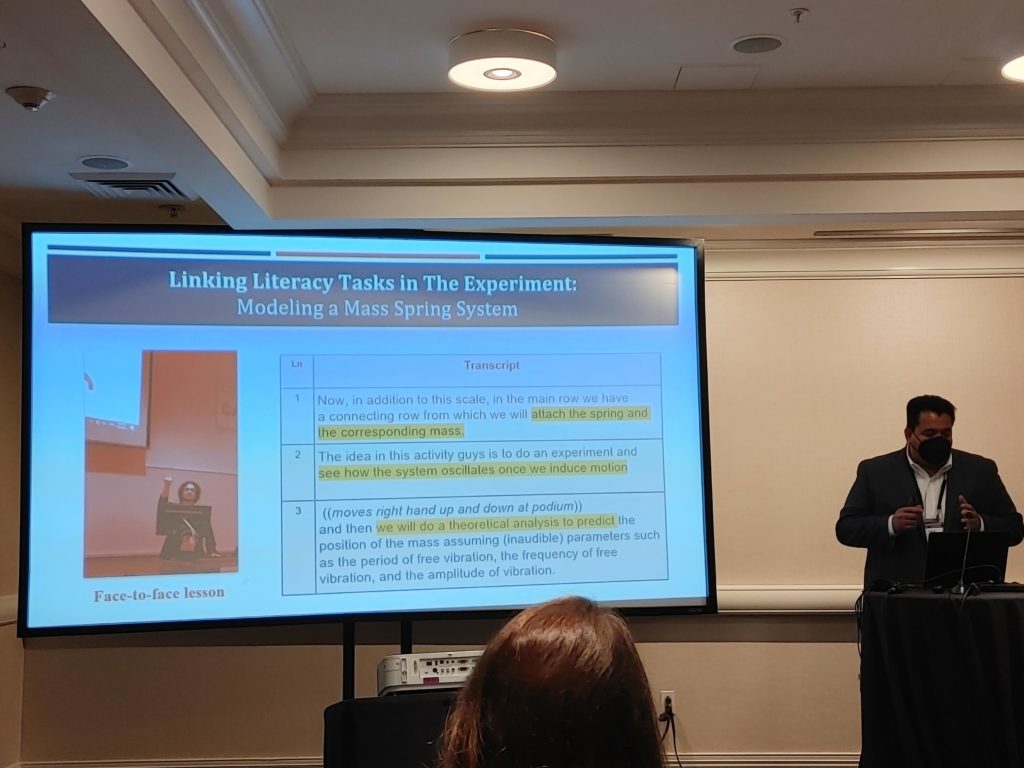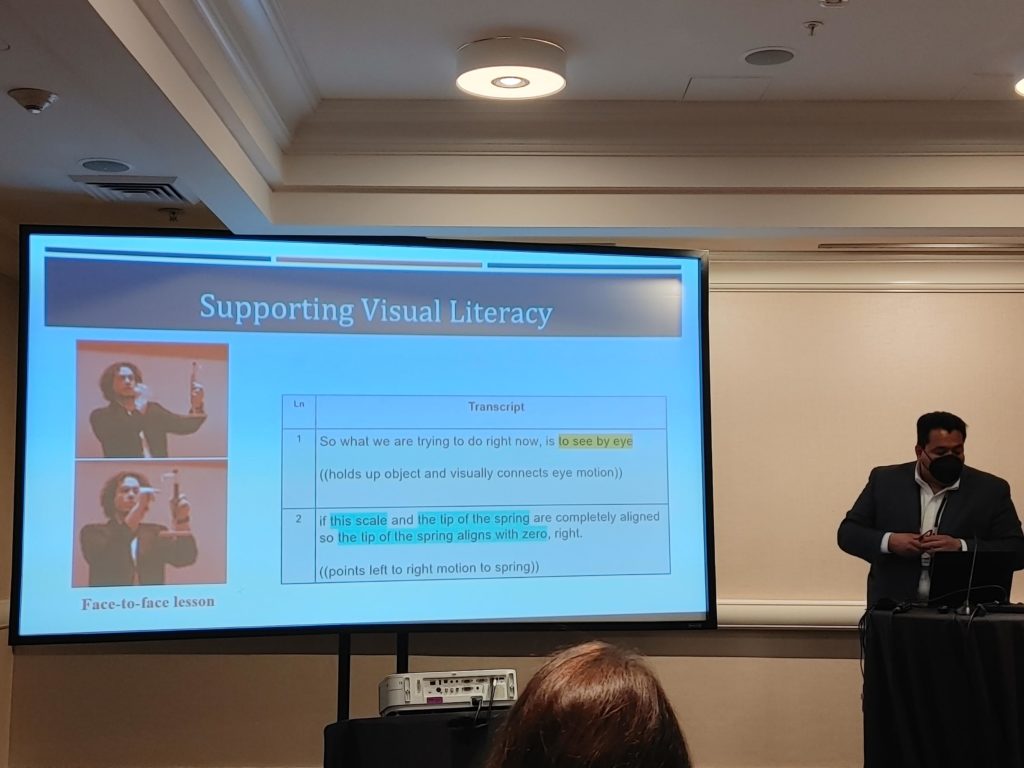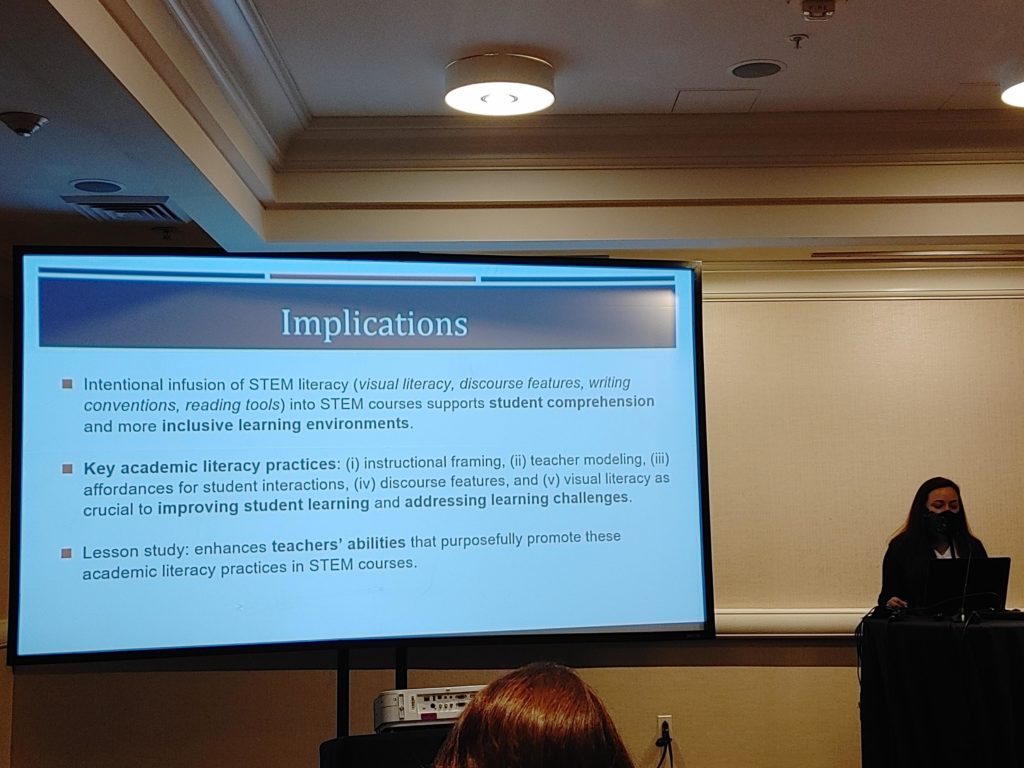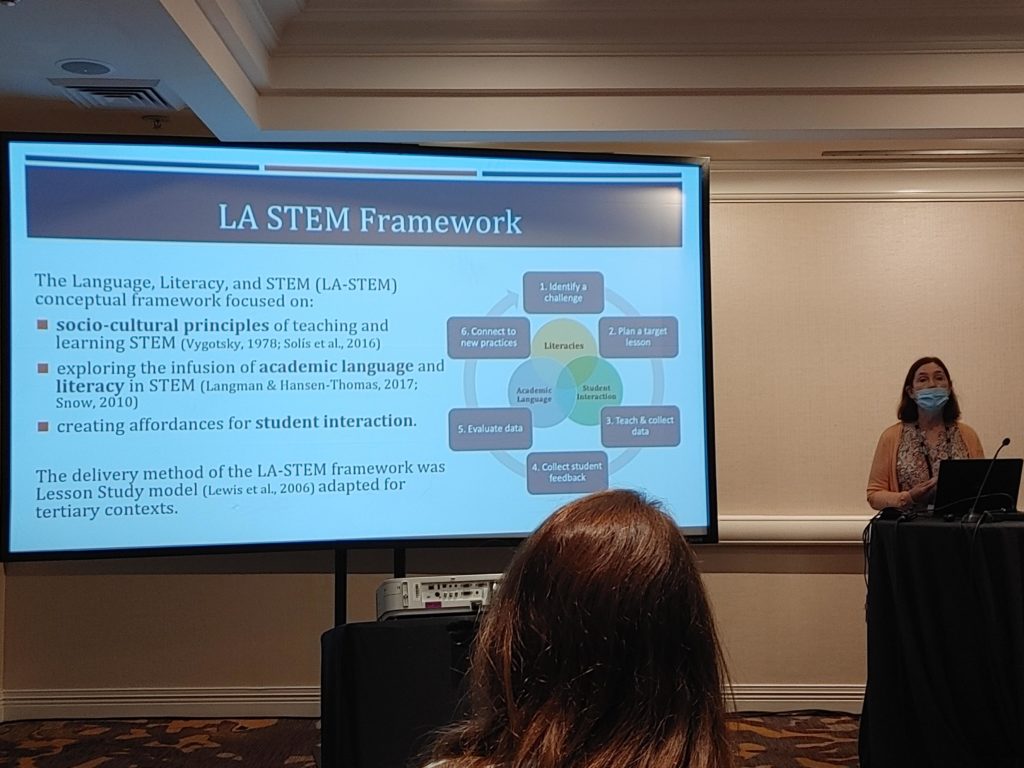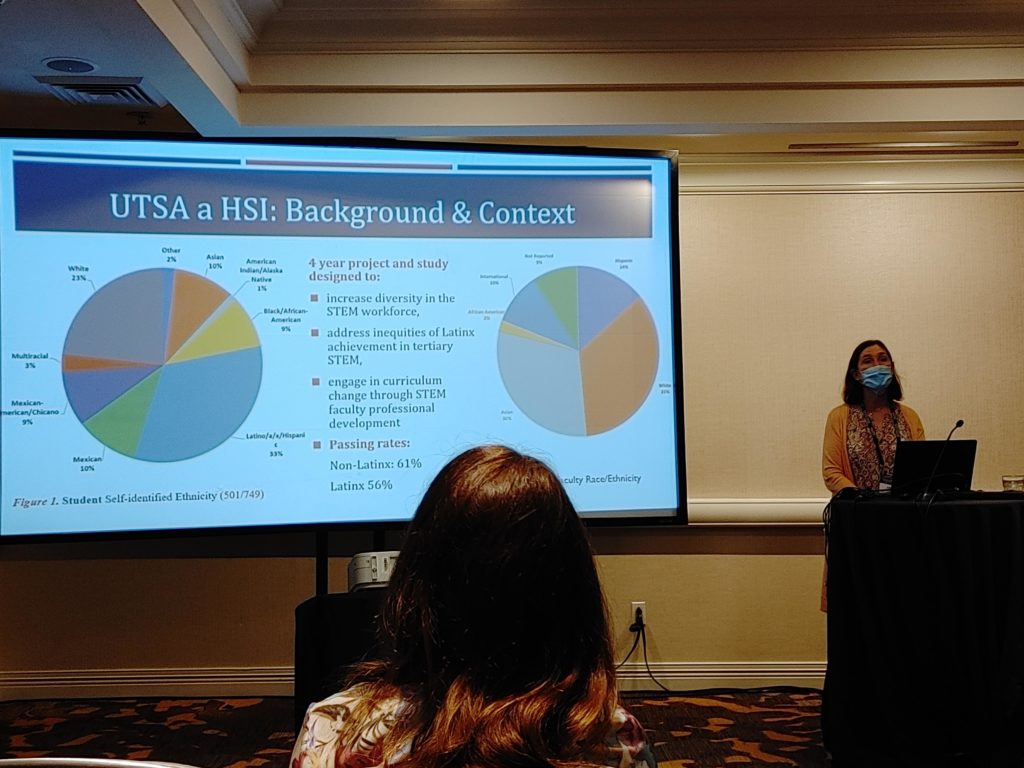Exploring Academic Literacy Infusion into Tertiary STEM Contexts
Abstract
This qualitative research explores how theoretical underpinnings of academic literacy are infused into the process of restructuring a focal lesson in a gateway Engineering course. This paper is part of a four-year Lesson Study (LS) project aimed at redesigning curriculum and instructional practices in STEM courses at a Hispanic-Serving Institution. Data are drawn from audio-recorded lesson planning meetings, video-recorded lesson implementation sessions, visual records of instructional materials, and student feedback. Findings show explicit attention to lesson framing, teacher modeling, affordances for student interactions, discourse features, and visual literacy results in positive changes in faculty pedagogical practices as well as student learning. The academic literacy-infused approach, while paired with LS, has shown potential as a sustainable professional development model in tertiary contexts.
Introduction
Understanding academic literacy and its connection to STEM education has become of central interest to researchers who examine learning through a sociocultural lens. In this paper, we extend this discussion to an examination of intentional academic literacy infusion in a tertiary setting, designated as a Hispanic-Serving Institution (HSI). Grounded in a discussion of how faculty in STEM fields, and in this case Engineering, can develop pedagogical competencies through a Lesson Study (LS) approach, we examine how academic literacy is infused into redesigned undergraduate Engineering lessons occupied by culturally and linguistically diverse (CLD) students. Previous research on LS as a professional development model in tertiary contexts shows promise for restructuring how faculty can collaboratively identify learning challenges related to STEM content competencies and discuss, plan, and implement a series of target lessons that address those challenges (Lewis et al., 2009). We address the following research question: “How do Engineering faculty infuse academic literacy into their planning and delivery of a target lesson over the course of two semesters of Spring and Fall 2020 in a gateway undergraduate Engineering course?”
Theoretical Framework and Related Literature
This research is framed within a sociocultural lens that focuses on diversity (Nasir & Hand, 2006; Strayhorn et al., 2013; Winterer et al., 2020) and students’ funds of knowledge (Mejia, 2014; Witkowsky et al., 2020), to understand and address persistent issues such as inequities in access and success among Latinx university students (Allen-Ramdial & Campbell, 2014; Boyce, 2017; Mallinson & Hudley, 2014; O’Leary et al., 2020). Research shows that explicit attention to academic literacy brings about a positive shift in faculty teaching orientation (Bailey & Butler, 2003; Perin, 2011) as well as minoritized student learning (Bunch & Kibler, 2015; Hernández-Castellano et al., 2017).
Broadly speaking, academic literacy has been conceptualized as the set of language practices required to develop and display proficiency or expertise in a particular discipline (Gee, 2015; Langman & Hansen-Thomas, 2017; Schleppegrell, 2004). In STEM contexts, academic literacy is understood through five key characteristics: (1) lesson framing, or discussions of content competencies in terms of connection with prior knowledge and accomplishment of learning goals of a lesson unit (Bing & Redish, 2009; Nguyen et al., 2016); (2) teacher modeling as a pedagogical tool to explain STEM concepts and procedures (Kaiser, 2017; Mousoulides et al., 2008); (3) affordances for student interactions, which bring about opportunities for active discussions of content, display of expertise, and cross-check of understanding among students (Solomon & Black, 2008; Tarim, 2009); (4) discourse features, which refers to explicit focus on academic language to display STEM knowledge regarding key mathematical concepts and procedures (Snow, 2010); and (5) visual literacy, or strategic integration of graphs, charts, formulas, diagrams, and realia to support teaching and learning specific STEM knowledge (Fransecky & Debes, 1972; Krejci et al., 2020; Lee & Fradd, 1998). Recognizing the complex nature of academic literacy, this paper builds on these five characteristics to examine (1) references to academic literacy and connection to big ideas in lesson delivery and (2) use of and reference to written materials that explain academic literacy and its connection to concepts and/or procedures at hand.
Methodology
We use a qualitative lens, informed by sociocultural perspectives of learning activity, to focus on how academic literacy is infused into this lower-division Engineering lesson on Mass Spring Systems (MSS) taught by Professor FH during the initial implementation of the restructured lesson in Spring 2020, and during the second implementation in Fall 2020. Data for this paper are drawn from our Lesson Study (LS) collaborations with university faculty engaged in an ongoing longitudinal project focused on restructuring STEM courses to improve student outcomes. Through the LS approach, the project has engaged 10 Engineering, Physics, and Education faculty in restructuring 15 focal lessons in lower and upper-division courses since Spring 2019. For this paper, we examine (1) observational data of one gateway Engineering course over the span of two semesters, Spring 2020 and Fall 2020, and (2) recorded LS planning meetings to explore how academic literacy is brought to attention in teaching and learning in the focal course. Using discourse analytic techniques (Gee, 2014), we analyze transcripts of audio and video recordings of focal lessons, including small group interactions, LS meetings, and student feedback (in interview and survey form). This approach provides a rich perspective on how faculty members engaged in professional development to develop orientations towards academic literacy over time. Part of the LS approach is to reteach focal lessons through an iterative process of refinement and improvement (Lewis et al., 2009).
While we acknowledge the improvisational, contingent, and intersubjective nature of teaching activities, we concentrate on how Professor FH grapples with infusing academic literacy into the MSS lesson over time and through specific instructional plans. At play here is both the pedagogical development of more inclusive teaching by Professor FH as well as the production of potentially portable teaching tools and artifacts that may be shared with other faculty. In our analysis of video-recorded observational data, we take a performative and intersubjective stance, rather than an evaluative stance, to understand how Professor FH may be developing his pedagogical orientation over time. That is, we consider interactional work and language use as culturally embedded in the achievement of the social order of any context and not random. Moreover, our analysis of lesson observations are also deeply informed by our pre-lesson and post-lesson collaborative planning conversations where Professor FH discusses his teaching plans and also reflections on the lesson.
Data Sources
This paper specifically focuses on the MSS lesson in Spring and Fall 2020 taught by Professor FH, a bilingual senior lecturer Engineering professor from Mexico with 5 years of teaching experience. This lesson was collaboratively created to address a learning challenge, which was students’ ability to translate word problems related to MSS into differential equations with initial conditions, solve these equations, and give physical interpretations of the solutions. The big idea was the application of Hook’s law and Newton’s second law in static equilibrium to determine the properties of an MSS and to describe its motion using differential equations and initial conditions.
To address the big idea, the professor first presented students with a multiple-choice question, requiring students to find the general solution to a differential equation problem as a pre-test. This was followed by a brief explanation of the application of concepts related to second-order differential equations to model MSS, involving free-damped motion, overdamped motion, and critically-damped motion using a PowerPoint presentation with visuals and examples. In the Spring 2020 in-person class, the professor modeled how to manipulate and calibrate an MSS realia. Meanwhile, in Fall 2020, an online simulator was used in place of the realia. There was a change of modality due to COVID-19. Afterward, students conducted static and dynamic analyses, recording their calculations in a handout while the professor monitored and assisted students with the process. Next, the students validated the theoretical predictions against the experimental data to draw conclusions about the theoretical and experimental agreement. Finally, as a post-test, the students were given a second multiple-choice problem.
Findings and Discussions
Our analysis describes how the focal lesson was initially implemented and then reimplemented by infusing academic literacy to explain the big idea of the lesson through attention to framing, modeling, visual literacy, and discourse features. Findings indicate that there were similarities and differences in planning, implementation, and reflection of lessons, all of which were designed to enhance an explicit focus on academic literacy. Notably, the focal lesson was taught initially in a face-to-face setting in Spring 2020 and again in a virtual setting in Fall 2020. Over the course of the two semesters, we find increasing complexity and more explicit discussions of academic literacy and how it is connected to the big idea. Lesson observations and faculty reflections indicate shifts from traditional lessons where explicit attention to framing is tied not only to procedural activities but also to conceptual knowledge. More specifically, both lesson plans in Spring and Fall 2020 include explicit communication of lesson objectives at the beginning of the instructional plan. Framing lessons by activating and eliciting prior knowledge from students was a way to pull for the coherence of related academic literacy knowledge; for example, discussions of lesson framing resulted in a multiple-choice pretest that aims to activate students’ prior knowledge by reviewing the concepts of second-order differential equations with constant coefficients (see above).
Most importantly, we found that instructional framing lays the groundwork for other components of academic literacy such as modeling, visual literacy, discourse features, and affordances for student interaction. For example, while the change in the modalities of teaching due to COVID-19 affected how visual literacy was used as a learning tool, this change in context also led to creative digital adaptations where attention to visual literacy was sustained. In Spring, although MSS realia were used, the attention to content and language represented visually in course handouts was limited. In Fall, however, as a result of the initial implementation, significant time was spent designing and modeling visual literacy for the virtual version of the MSS. More specifically, the use of manipulatives was adapted into digital form using the PhET interactive simulation software to model the experiment. The handout for the Fall was modified accordingly with descriptions of different MSS components and how to utilize different features of the simulation to conduct the experiment (see Figure 1).
Figure 1: Descriptions of MSS simulation in the Fall 2020 handout
We also find greater integration of discourse features during framing and modeling. For instance, we see a tighter connection between academic-level key terms and concepts in the second iteration of the lesson in the Fall, where Professor FH strategically communicated the objective of the first part of the experiment while modeling how to conduct the experiment. In doing so, he explicitly addressed the key terms by labeling the virtual objects such as “mass”, “weight”, and “force”, as well as showing how they are displayed in the simulation software (see also Figure 1).
Lastly, attention to discourse features in framing and throughout lesson materials also impacted how students engaged in small group activities intended to promote student interactions during the lesson. A characteristic of this focus emphasizes the use of natural language during the formulation of tasks during group work activities. For example, in Spring, focused groups of students were encouraged to discuss in the language they felt comfortable with, which resulted in them informally and formally code-switching between English and Spanish to discuss the experiment processes as well as appropriate STEM concepts. The natural language here refers to the language that naturally develops in situ, which could be either the use of technical terms or the use of one’s native speech to accomplish the activity goals, develop a deeper understanding of the topic, and communicate that understanding to others. However, in Fall, affordances for student interactions were not sustained due to certain limitations in virtual contexts.
Significance of the Study
This study adds to the existing literature regarding multiple ways in which intentional infusion of academic literacy into STEM courses plays a significant role in closing the achievement gap among CLD students enrolled in HSI (Contreras, 2017; Garcia, 2018; Núñez et al., 2015). We identified key academic literacy practices including lesson framing, teacher modeling, affordances for student interactions, discourse features, and visual literacy as crucial to improving student learning and addressing learning challenges. The use of Lesson Study proved to be a promising professional development approach to enhance teachers’ abilities that purposefully promote these academic literacy practices in STEM courses.
Presentation Slides
References
Allen-Ramdial, S.-A. A., & Campbell, A. G. (2014). Reimagining the pipeline: Advancing STEM diversity, persistence, and success. BioScience, 64(7), 612–618.
Bailey, A. L., & Butler, F. A. (2003). An evidentiary framework for operationalizing academic language for broad application to K-12 education: A design document. CSE report. https://eric.ed.gov/?id=ED483026
Bing, T. J., & Redish, E. F. (2009). Analyzing problem solving using math in physics: Epistemological framing via warrants. Physical Review Special Topics – Physics Education Research, 5(2), 020108. https://doi.org/10.1103/PhysRevSTPER.5.020108
Boyce, A. S. (2017). Lessons learned using a values-engaged approach to attend to culture, diversity, and equity in a STEM program evaluation. Evaluation and Program Planning, 64, 33–43. https://doi.org/10.1016/j.evalprogplan.2017.05.018
Bunch, G. C., & Kibler, A. K. (2015). Integrating language, literacy, and academic development: Alternatives to traditional English as a second language and remedial English for language minority students in community colleges. Community College Journal of Research and Practice, 39(1), 20–33. https://doi.org/10.1080/10668926.2012.755483
Contreras, F. (2017). Latino faculty in Hispanic-serving institutions: Where is the diversity? Association of Mexican American Educators Journal, 11(3), 223–250. https://doi.org/10.24974/amae.11.3.368
Fransecky, R. B., & Debes, J. L. (1972). Visual literacy: A way to learn–A way to teach. https://eric.ed.gov/?id=ED064884
Garcia, G. A. (2018). Decolonizing leadership practices: Towards equity and justice at Hispanic-serving institutions (HSIs) and emerging HSIs (eHSIs). Journal of Transformative Leadership & Policy Studies, 7(2), 25–39. https://doi.org/10.36851/jtlps.v7i2.505
Gee, J. P. (2014). An introduction to discourse analysis: Theory and method (4th edition). Routledge.
Gee, J. P. (2015). Social linguistics and literacies (5th edition). Routledge.
Hernández-Castellano, P. M., Marrero-Alemán, M. D., Aranda-Loureiro, A. M., Ortega-García, F., Paz-Hernández, R., & Benítez-Vega, A. N. (2017). Development of interactive learning materials in engineering of manufacturing processes. Materials Science Forum, 903, 63–69. http://dx.doi.org.libweb.lib.utsa.edu/10.4028/www.scientific.net/MSF.903.63
Kaiser, G. (2017). The teaching and learning of mathematical modeling. In J. Cai (Ed.), Compendium for Research in Mathematics Education (pp. 267–291). National Council of Teachers of Mathematics, Inc.
Krejci, S. E., Link to external site, this link will open in a new window, Ramroop-Butts, S., Torres, H. N., Isokpehi, R. D., & Link to external site, this link will open in a new window. (2020). Visual literacy intervention for improving undergraduate student critical thinking of global sustainability issues. Sustainability, 12(23), 10209–10227. http://dx.doi.org.libweb.lib.utsa.edu/10.3390/su122310209
Langman, J., & Hansen-Thomas, H. (Eds.). (2017). Discourse analytic perspectives on STEM education: Exploring interaction and learning in the multilingual classroom. Springer International Publishing. https://doi.org/10.1007/978-3-319-55116-6
Lee, O., & Fradd, S. H. (1998). Science for all, including students from non-English-language backgrounds. Educational Researcher, 27(4), 12–21. https://doi.org/10.3102/0013189X027004012
Lewis, C. C., Perry, R. R., & Hurd, J. (2009). Improving mathematics instruction through lesson study: A theoretical model and North American case. Journal of Mathematics Teacher Education, 12(4), 285–304. https://doi.org/10.1007/s10857-009-9102-7
Mallinson, C., & Hudley, A. H. C. (2014). Partnering through science: Developing linguistic insight to address educational inequality for culturally and linguistically diverse students in U.S. STEM education. Language and Linguistics Compass, 8(1), 11–23. https://doi.org/10.1111/lnc3.12060
Mejia, J. A. (2014). A sociocultural analysis of Latino high school students’ funds of knowledge and implications for culturally responsive engineering education [Ph.D., Utah State University]. http://www.proquest.com/docview/1658771742/abstract/CCAFCEC6AA494F05PQ/1
Mousoulides, N. G., Christou, C., & Sriraman, B. (2008). A modeling perspective on the teaching and learning of mathematical problem solving. Mathematical Thinking and Learning, 10(3), 293–304. https://doi.org/10.1080/10986060802218132
Nasir, N. S., & Hand, V. M. (2006). Exploring sociocultural perspectives on race, culture, and learning. Review of Educational Research, 76(4), 449–475. https://doi.org/10.3102/00346543076004449
Nguyen, H. D., Chari, D. N., & Sayre, E. C. (2016). Dynamics of students’ epistemological framing in group problem solving. European Journal of Physics, 37(6), 065706. https://doi.org/10.1088/0143-0807/37/6/065706
Núñez, A.-M., Hurtado, S., & Galdeano, E. C. (2015). Why study Hispanic-serving institutions? In A.-M. Núñez, S. Hurtado, & E. C. Sylvia (Eds.), Hispanic-Serving Institutions: Advancing Research and Transformative Practice (1st Edition, pp. 1–22). Routledge.
O’Leary, E. S., Shapiro, C., Toma, S., Sayson, H. W., Levis-Fitzgerald, M., Johnson, T., & Sork, V. L. (2020). Creating inclusive classrooms by engaging STEM faculty in culturally responsive teaching workshops. International Journal of STEM Education, 7(1), 32. https://doi.org/10.1186/s40594-020-00230-7
Perin, D. (2011). Facilitating student learning through contextualization: A review of evidence. Community College Review, 39(3), 268–295. https://doi.org/10.1177/0091552111416227
Schleppegrell, M. J. (2004). The language of schooling: A functional linguistics perspective. Routledge. https://doi.org/10.4324/9781410610317
Snow, C. E. (2010). Academic language and the challenge of reading for learning about science. Science, 328(5977), 450–452. http://dx.doi.org.libweb.lib.utsa.edu/10.1126/science.1182597
Solomon, Y., & Black, L. (2008). Talking to learn and learning to talk in the mathematics classroom. In N. Mercer & S. Hodgkinson (Eds.), Exploring Talk in School: Inspired by the Work of Douglas Barnes (pp. 73–90). SAGE Publications Ltd. https://doi.org/10.4135/9781446279526.n5
Strayhorn, T. L., Long, L. L., Kitchen, J. A., Williams, M. S., & Stentz, M. E. (2013). Academic and social barriers to black and Latino male collegians’ success in engineering and related STEM fields. Association for Engineering Education – Engineering Library Division Papers, 23.132.1-23.132.14. http://www.proquest.com/docview/2317875804?pq-origsite=primo
Tarim, K. (2009). The effects of cooperative learning on preschoolers’ mathematics problem-solving ability. Educational Studies in Mathematics, 72(3), 325–340.
Winterer, E. R., Froyd, J. E., Borrego, M., Martin, J. P., & Foster, M. (2020). Factors influencing the academic success of Latinx students matriculating at 2-year and transferring to 4-year US institutions—implications for STEM majors: A systematic review of the literature. International Journal of STEM Education, 7(1), 34. https://doi.org/10.1186/s40594-020-00215-6
Witkowsky, P., Obregon, V., Bruner, B., & Alanis, J. (2020). Connecting familismo and higher education: Influence of Spanish language PFMO programs on Latinx family involvement and sense of belonging. Journal of Hispanic Higher Education, 19(4), 354–368. https://doi.org/10.1177/1538192718810429

